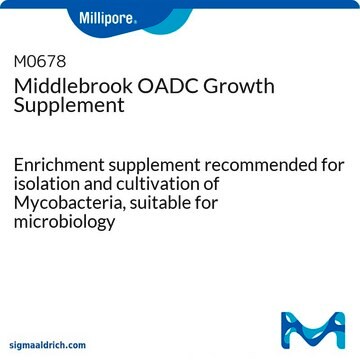M0428
Middlebrook 7H11 Agar Base
suitable for microbiology, NutriSelect® Plus
Synonym(s):
Media for culturing Mycobacteria
About This Item
Recommended Products
sterility
non-sterile
Quality Level
product line
BioChemika
form
powder
shelf life
limited shelf life, expiry date on the label
manufacturer/tradename
NutriSelect® Plus
storage condition
protect from light at room temperature
technique(s)
microbe id | susceptibility testing: suitable
microbiological culture: suitable
final pH
6.6±0.2 (25 °C)
application(s)
clinical testing
food and beverages
life science and biopharma
veterinary
microbiology
suitability
mycobacteria
Related Categories
General description
Application
The latter has the following advantages over the egg-based media
The Middlebrook 7H11 agar base does not liquify easily in the presence of contaminating proteolytic organisms
There is less inactivation of added drugs when egg ingredients are absent
Components
Casein enzymatic hydrolysate, 1.00
Ammonium sulfate, 0.50
Monopotassium phosphate, 1.50
Disodium phosphate, 1.50
Sodium citrate, 0.40
Magnesium sulfate, 0.05
L-Glutamic acid, 0.50
Ferric ammonium citrate, 0.04
Pyridoxine, 0.001
Biotin, 0.0005
Malachite green, 0.001
Agar, 15.00
Preparation Note
Footnote
The designations basic, plus, or prime are added to indicate the quality control level, from basic quality control to standard QC plus to prime for full regulatory compliance.
Legal Information
related product
Storage Class Code
11 - Combustible Solids
WGK
WGK 3
Flash Point(F)
Not applicable
Flash Point(C)
Not applicable
Choose from one of the most recent versions:
Already Own This Product?
Find documentation for the products that you have recently purchased in the Document Library.
Customers Also Viewed
Articles
Identifying Mycobacterium species crucial due to varying clinical significance; some pathogenic, others not.
Identifying Mycobacterium species crucial due to varying clinical significance; some pathogenic, others not.
Identifying Mycobacterium species crucial due to varying clinical significance; some pathogenic, others not.
Identifying Mycobacterium species crucial due to varying clinical significance; some pathogenic, others not.
Our team of scientists has experience in all areas of research including Life Science, Material Science, Chemical Synthesis, Chromatography, Analytical and many others.
Contact Technical Service










